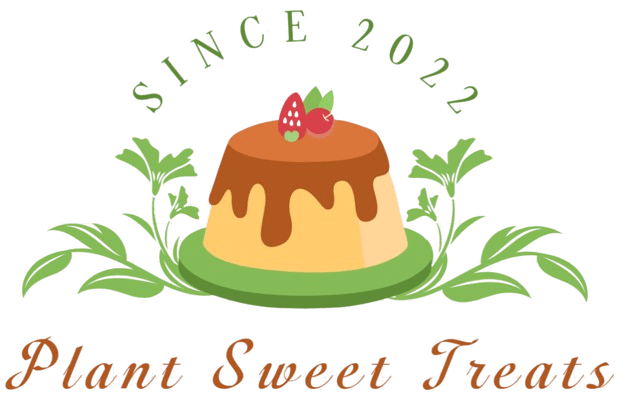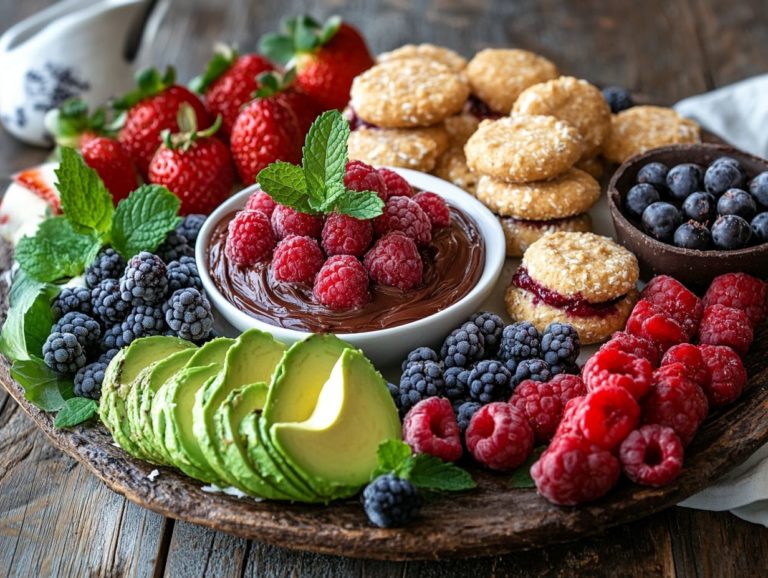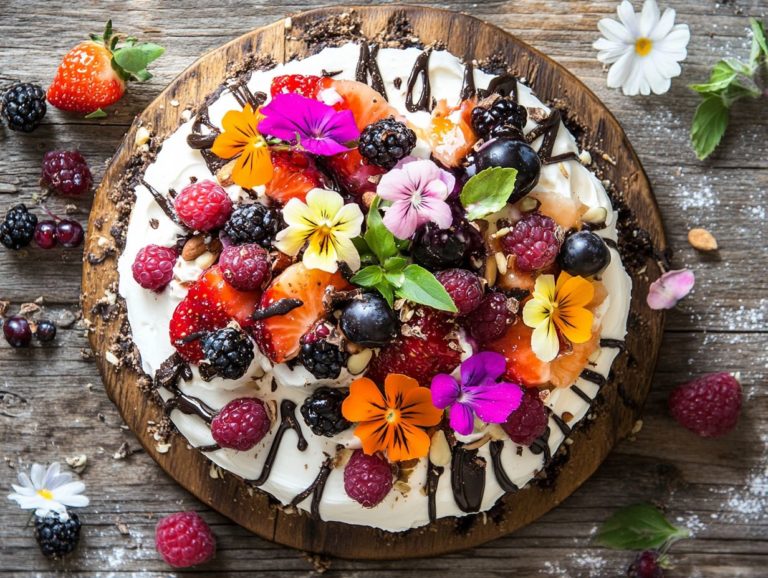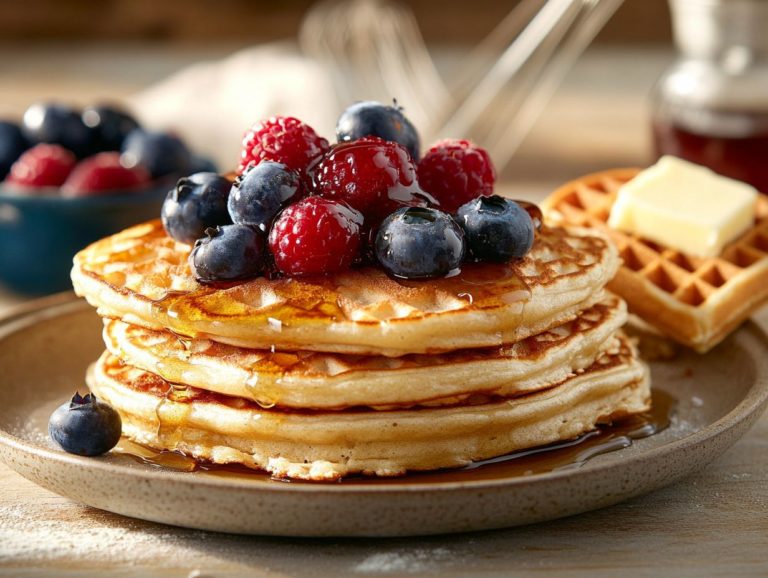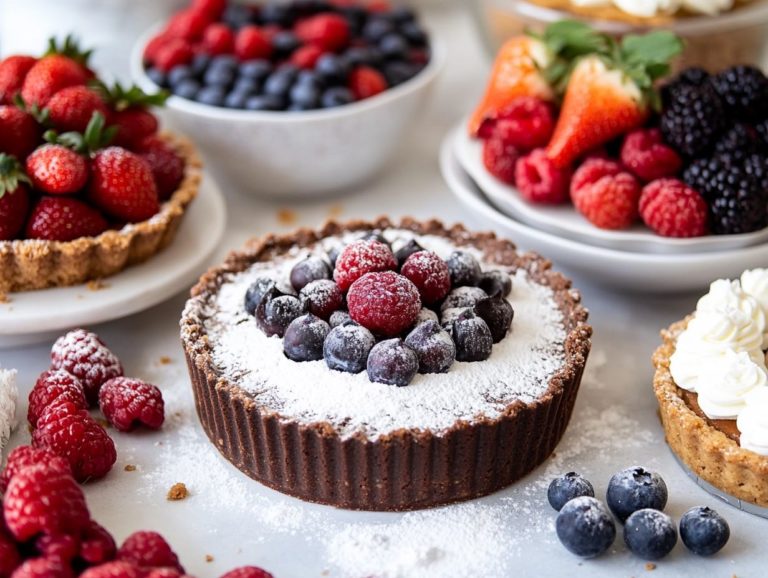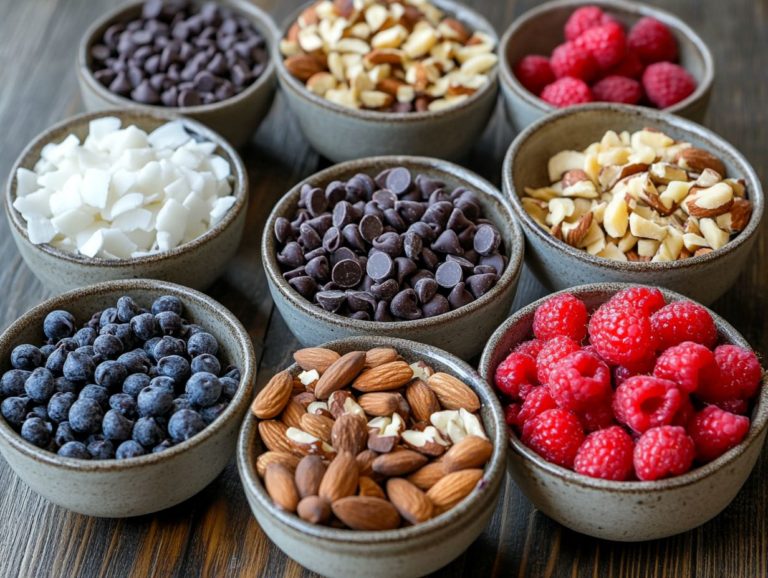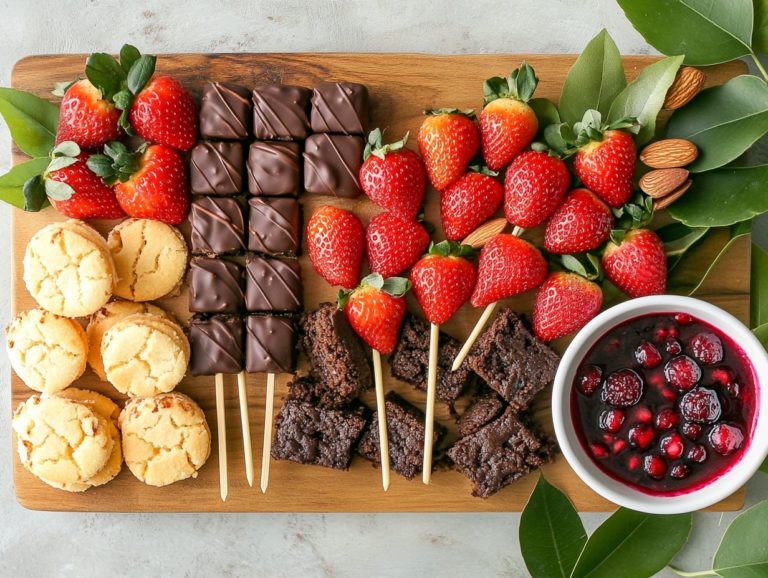5 Must-Have Ingredients for Gluten-Free Baking
Gluten-free baking unfolds as a delightful adventure, inviting you to explore a rich tapestry of flavors and textures, all without the gluten. By using certified gluten-free products, you ensure the safety and quality of your baking goods.
Whether you re navigating gluten intolerance or simply seeking to broaden your culinary repertoire, grasping the essential ingredients like gluten-free flour, almond flour, and tapioca starch is crucial for your success in the kitchen.
Consider these five indispensable ingredients that can elevate your gluten-free baked goods:
- Versatile gluten-free flour blends
- Xanthan gum
- Baking powder
- Baking soda
- Alternative sweeteners like maple syrup
Ready to elevate your baking? Check out King Arthur gluten-free products!
Contents
- Key Takeaways:
- 1. Gluten-Free Flour Blend
- 2. Xanthan Gum
- 3. Baking Powder
- 4. Baking Soda
- 5. Alternative Sweeteners
- What Is Gluten-Free Baking and Why Is It Important?
- What Are Some Common Gluten-Free Flour Blends?
- How Does Xanthan Gum Help with Gluten-Free Baking?
- What Is the Role of Baking Powder and Baking Soda in Gluten-Free Baking?
- What Are Some Alternative Sweeteners That Can Be Used in Gluten-Free Baking?
- Are There Any Other Important Ingredients for Gluten-Free Baking?
- Frequently Asked Questions
- What are the 5 must-have ingredients for gluten-free baking?
- Why is gluten-free flour an essential ingredient for gluten-free baking?
- What is the purpose of xanthan gum in gluten-free baking?
- Can baking powder and baking soda be substituted in gluten-free baking?
- Why are eggs important in gluten-free baking?
- Do I need to use all 5 must-have ingredients in gluten-free baking?
Key Takeaways:
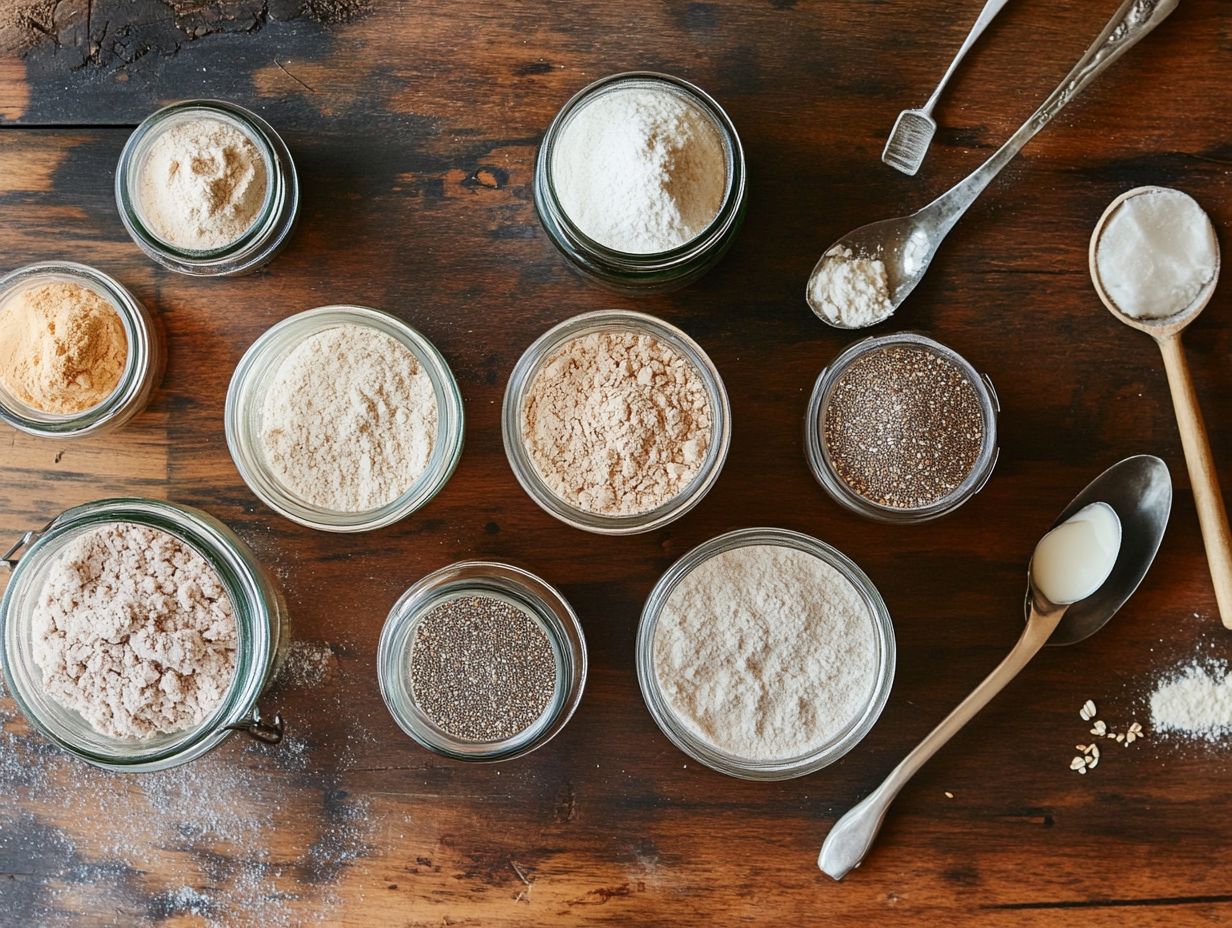
- Invest in a good gluten-free flour blend to create a similar texture and taste to traditional baking.
- Xanthan gum is a crucial ingredient in gluten-free baking as it helps bind the ingredients and give the baked goods structure.
- Baking powder and baking soda are essential leavening agents in gluten-free baking to help the dough rise and create a light and fluffy texture.
1. Gluten-Free Flour Blend
Creating your own gluten-free flour blend is essential if you’re following a gluten-free diet, especially if you have celiac disease. It opens up a world of baking possibilities where you can whip up delicious and safe treats.
By carefully selecting gluten-free ingredients like almond flour, coconut flour, and tapioca starch, you can achieve the perfect texture and taste in your baked goods while meeting your dietary needs and preventing contact with gluten-containing grains such as wheat, barley, and rye.
Using a variety of gluten-free flours not only enhances flavor but also provides numerous health benefits, such as increased protein and fiber content. For example, almond flour is packed with essential nutrients and healthy fats, while coconut flour is rich in fiber and superb at moisture absorption perfect for those seeking lower-carb alternatives.
By combining these flours in just the right ratios, you can create bakery delights that maintain the moistness and structure we often associate with gluten-based flours. Ingredients like flax seeds can also enhance the texture and protein content. It s vital to choose certified gluten-free products, as this label assures you that the ingredients have been tested for gluten contamination, keeping those with severe gluten sensitivities safe.
Proper handling during preparation and baking is crucial to prevent cross-contact, thereby protecting the health of those who must adhere strictly to their dietary restrictions.
2. Xanthan Gum
Xanthan gum is a critical ingredient in your gluten-free baking arsenal, serving as a binding agent that replicates the elasticity of gluten. This is crucial for achieving that perfect texture in your baked goods.
It expertly stabilizes gluten-free flour blends, allowing for a successful baking experience that ensures your bread and pastries rise beautifully and retain their shape.
Without xanthan gum, you may find your gluten-free creations turning out crumbly and dry, missing the chewy texture that defines traditional recipes. This ingredient acts as the glue, holding everything together and providing a consistent structure throughout your baked products.
When you’re ready to incorporate xanthan gum, a helpful rule of thumb is to use about one teaspoon for every cup of gluten-free flour. Of course, feel free to make adjustments based on your specific recipe requirements.
If you have allergies or dietary restrictions, fear not alternatives like ground chia seeds, psyllium husk powder, or flax seeds can do the trick. Both of these options offer binding properties while adding their unique flavors, making them excellent substitutes for your baking adventures.
3. Baking Powder
Baking powder is a critical leavening agent in your gluten-free baking arsenal. It plays a pivotal role in introducing rise and lightness to your favorite baked goods. Its chemical reaction generates carbon dioxide bubbles, creating that coveted fluffy texture that elevates recipes like cakes, muffins, and pancakes to new heights.
Unlike baking soda, which needs an acidic partner to get going, baking powder is an independent leavening agent, containing both an acid and a base. This means it springs into action as soon as it s moistened and heated. This is especially crucial in gluten-free baking, where achieving that perfect rise can be a real challenge due to the absence of gluten.
For example, think about how gluten-free brownies thrive with the help of baking powder, delivering that gooey texture while still rising beautifully.
When you re on the hunt for gluten-free options, be sure to choose brands that clearly indicate they are gluten-free. Cross-contamination can sneak in during production. Double-acting baking powder is often the preferred choice. It offers consistent leavening action throughout the baking journey, ensuring your creations turn out just right every time.
4. Baking Soda
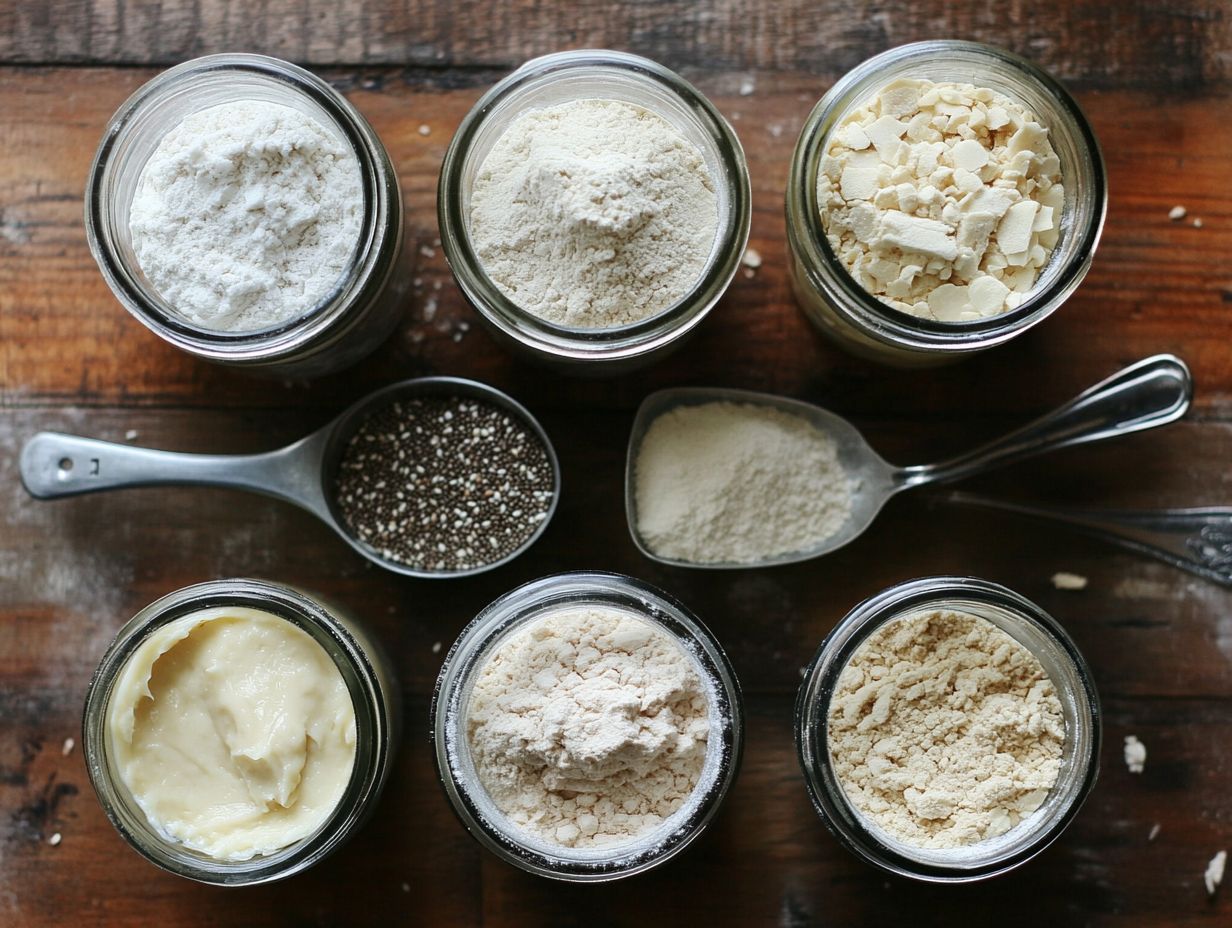
Baking soda is an essential ally in gluten-free baking. This powerful leavening agent reacts with acid to produce carbon dioxide, ensuring your gluten-free baking recipes achieve a perfect rise. This allows your baked goods to attain that ideal texture. Its remarkable effectiveness shines in recipes like cookies, quick breads, and pancakes, making it a staple ingredient in gluten-free formulations.
What sets baking soda apart is its unique natural reaction, distinguishing it from baking powder, which contains both an acid and a base and only requires moisture to activate. When you use baking soda, pairing it with suitable acidic ingredients such as yogurt, lemon juice, or apple cider vinegar is crucial for optimal leavening. These acids not only help create that delightful rise, but they also enhance the overall flavor and moisture of your creations.
In your gluten-free baking adventures, combining baking soda with nut flours or starches can lead to incredibly light and airy textures. This elevates your overall baking experience to new heights.
5. Alternative Sweeteners
Alternative sweeteners, such as maple syrup, offer you a natural and healthier option to elevate the flavor of your gluten-free baked goods. By incorporating these sweeteners, you can craft delicious treats without the drawbacks of refined sugars. This makes your gluten-free baking both pleasurable and mindful of health.
Among the numerous alternatives, agave nectar, coconut sugar, and erythritol particularly stand out for their unique flavors and lower glycemic indices. Agave nectar is remarkably sweet, so a little goes a long way in your recipes. Meanwhile, coconut sugar imparts a delightful caramel-like profile that adds depth to your baked creations. Erythritol, on the other hand, is a zero-calorie sugar alcohol that you can use in larger amounts without significantly altering the taste.
To get the best results when you substitute these sweeteners for traditional sugars, tweak the liquid content or baking time for a perfect bake! This not only enhances your baking experience but also keeps health benefits front and center.
What Is Gluten-Free Baking and Why Is It Important?
Gluten-free baking is truly an art form, allowing you to create delectable baked goods without the use of gluten-containing ingredients like wheat, barley, or rye. It plays a crucial role in the lives of those adhering to a gluten-free diet or dealing with celiac disease. This is especially vital for those with celiac disease or gluten sensitivities. Embracing gluten-free baking not only caters to dietary restrictions but also unveils a realm of delightful possibilities through alternative flours such as almond flour, coconut flour, and tapioca starch. It also promotes health benefits linked to a gluten-free lifestyle.
For many, diving into gluten-free baking isn t merely a necessity. It s a rewarding culinary adventure that enables those with gluten intolerances to indulge in treats once deemed off-limits. The health benefits of a gluten-free lifestyle are immense, promoting digestive health and overall well-being. With growing awareness of gluten-related disorders, you ll find a vast array of gluten-free ingredients at your disposal.
These ingredients not only mimic the delightful textures and flavors of traditional baked goods but also inspire creativity in your kitchen. Think about using flaxseed meal as a binding agent or experimenting with a variety of nuts and seeds, such as oats, amaranth, buckwheat, and rice flour. The journey to crafting delicious gluten-free recipes is rich with opportunities for innovation, inviting you to explore and savor each creation.
What Are Some Common Gluten-Free Flour Blends?
Common gluten-free flour blends typically include a mix of various flours, such as:
- Almond flour: moist texture, nutty flavor
- Coconut flour: highly absorbent, great for denser recipes
- Tapioca starch: adds chewiness and elasticity
Each offers its unique textures and nutritional profiles to your baked goods. These blends are artfully crafted to mimic the properties of traditional wheat flour, ensuring you can enjoy a successful baking experience without the gluten.
Take almond flour, for example; it infuses your creations with a moist texture and a delightful hint of nuttiness, making it an excellent choice for cakes and cookies. Coconut flour, on the other hand, is highly absorbent and works wonders in recipes that call for a denser consistency, such as pancakes or muffins. Then there’s tapioca starch, which adds a wonderful chewiness and enhances elasticity, making it a go-to for gluten-free bread recipes.
By exploring these flour options, such as almond flour, coconut flour, and tapioca starch, you can unlock a vast array of gluten-free baking possibilities. Imagine combining multiple flours to create a custom blend tailored specifically to your recipes, like a versatile all-purpose mix that s perfect for cookies, breads, or even delicious pizza crusts.
How Does Xanthan Gum Help with Gluten-Free Baking?
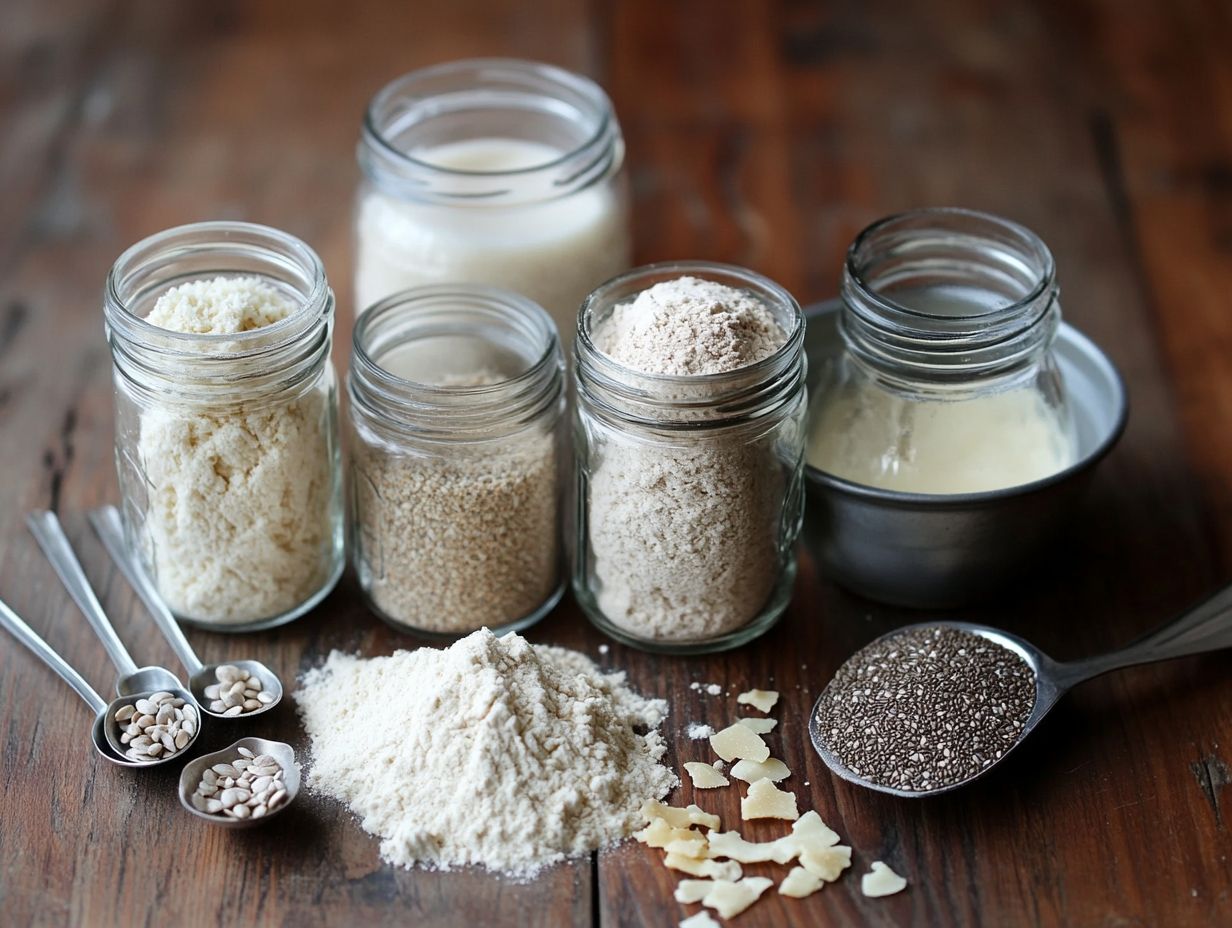
Xanthan gum is an essential player in the world of gluten-free baking, acting as a binding agent that elevates the texture and structure of your baked creations. By imitating gluten’s elasticity, xanthan gum ensures that your cakes, cookies, and breads hold their shape beautifully, preventing any crumbling and creating a delightful eating experience for those following a gluten-free diet. This is particularly important for individuals with celiac disease or gluten intolerance.
This remarkable type of carbohydrate comes from the fermentation of glucose or sucrose by the bacteria Xanthomonas campestris, a type of bacteria that offers far more than mere structural support. It absorbs water to form a gel-like consistency, helping to retain moisture and extend the freshness of your gluten-free products.
Many home bakers tend to underestimate the significance of using xanthan gum in the proper proportions, leading to misconceptions about its effectiveness. Using too little can result in dense and dry outcomes, while too much can create an unappealing gummy texture.
It s also a common myth that xanthan gum can directly replace gluten in every recipe. In reality, it works best when combined with a blend of gluten-free flours to achieve the results you desire.
What Is the Role of Baking Powder and Baking Soda in Gluten-Free Baking?
Both baking powder and baking soda are essential ingredients that help baked goods rise in gluten-free baking. They provide the lift and texture needed to create treats that closely resemble traditional baked goods.
Understanding how these two ingredients work together can enhance your gluten-free recipes. It ensures they rise perfectly and achieve the desired crumb structure.
Baking soda is pure sodium bicarbonate. It needs an acidic ingredient, like vinegar or yogurt, to activate its leavening properties. This activation results in the formation of carbon dioxide bubbles.
On the other hand, baking powder contains both acid and base, so it only requires moisture and heat to produce gas. This key distinction influences how you balance your recipe ingredients for the best results.
Take gluten-free pancakes, for example. They often call for baking soda, which reacts with buttermilk, and baking powder, which adds extra lift. This combination results in an irresistibly fluffy texture.
In gluten-free muffins, using both ensures even rising and a delightful crumb. This mimics the texture of their gluten-containing counterparts.
By mastering these ingredients, you re on your way to creating gluten-free delights that everyone will enjoy!
What Are Some Alternative Sweeteners That Can Be Used in Gluten-Free Baking?
In gluten-free baking, alternative sweeteners like maple syrup, honey, and coconut sugar offer delightful natural sweetness. They also provide a range of health benefits compared to refined sugars.
These sweeteners enhance the flavor of your baked creations. They cater to various dietary preferences, making them a stellar choice for the health-conscious baker.
Consider options like agave nectar, stevia, and date sugar. Each brings unique properties to the mix, influencing both the taste and texture of your final product.
For example, agave nectar has a low glycemic index, helping you maintain steady blood sugar levels. Meanwhile, stevia delivers a no-calorie sweetness that surpasses traditional sugar.
When you use these alternative sweeteners, you might need to adjust your liquid ratios or baking times. Some sweeteners, like honey, add extra moisture, which can lead to denser results.
The sweetener you select aligns with your health goals and opens up a world of flavor possibilities in your gluten-free baking adventures.
Are There Any Other Important Ingredients for Gluten-Free Baking?
In addition to gluten-free flours and leavening agents, incorporating other key ingredients can elevate your gluten-free baking experience. Consider flax seeds, oats, amaranth, buckwheat, rice flour, and corn.
These ingredients boost nutrition and enhance texture while broadening the versatility of your recipes. This ensures you cater to a variety of dietary needs.
Flax seeds are packed with omega-3 fatty acids and serve as a natural binder. They make a fantastic addition to doughs and batters.
When you choose certified gluten-free oats, you add a hearty flavor while increasing fiber content. This can enhance both satiety and digestion.
Amaranth brings a delightful nutty taste and boosts protein levels. Buckwheat introduces a unique earthy quality to your creations.
Rice flour and corn are versatile bases for various baked goods. To maximize their potential, consider mixing these flours in different ratios. Incorporate seeds and grains gradually into your recipes.
This thoughtful approach will help you achieve a delightful balance of flavor and texture in your culinary endeavors.
Frequently Asked Questions

What are the 5 must-have ingredients for gluten-free baking?
The 5 must-have ingredients for gluten-free baking are gluten-free flour, xanthan gum, baking powder, baking soda, and eggs.
Gluten-free baking has gained immense popularity as more people seek alternatives to traditional ingredients. Whether due to health concerns or lifestyle choices, it’s essential to understand the key components that ensure delicious results.
Why is gluten-free flour an essential ingredient for gluten-free baking?
Gluten-free flour is made from alternative grains or flours such as rice, almond, or coconut. It is necessary to use gluten-free flour to avoid any gluten-containing grains like wheat, rye, or barley.
What is the purpose of xanthan gum in gluten-free baking?
Xanthan gum, a common thickening agent, is used in gluten-free baking as a binding agent. It helps give baked goods structure and prevents them from being crumbly.
Can baking powder and baking soda be substituted in gluten-free baking?
Yes, baking powder and baking soda can be used in gluten-free baking. Make sure to check if they are labeled as certified gluten-free to avoid any cross-contact.
Why are eggs important in gluten-free baking?
Eggs are a crucial ingredient in gluten-free baking because they add moisture, structure, and stability to baked goods.
Do I need to use all 5 must-have ingredients in gluten-free baking?
For the best results, make sure to use all 5 must-have ingredients! You can experiment with different alternatives and substitutions to find what works best for you.
